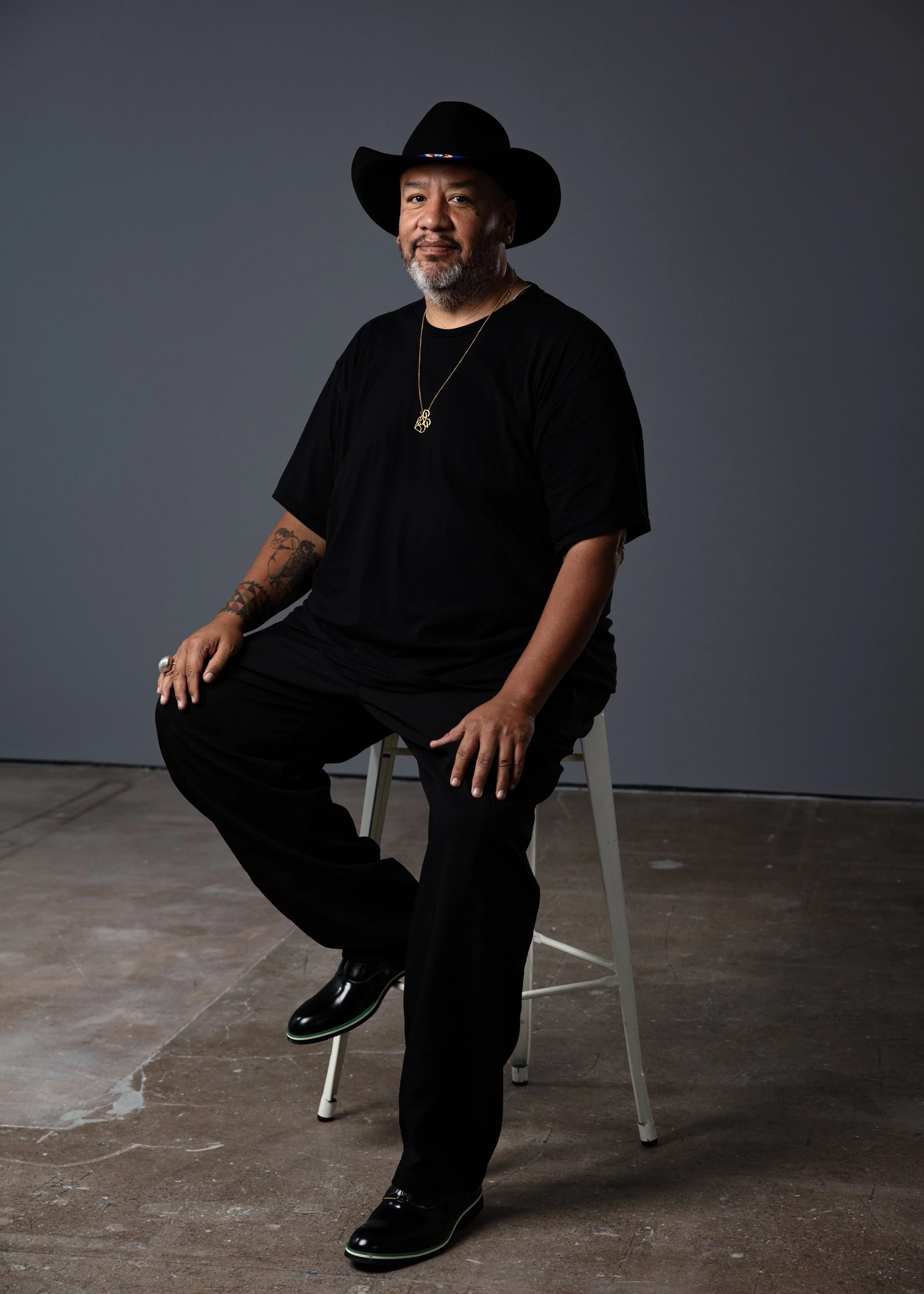Jeffrey Gibson Presents New Work and Dynamic Programming at Venice Biennale
Artist Jeffrey Gibson. Photo by Cara Romero.
Portland Art Museum in Oregon and SITE Santa Fe in New Mexico, in cooperation with the U.S. Department of State’s Bureau of Educational and Cultural Affairs, will present Jeffrey Gibson as the representative for the United States at the 60th International Art Exhibition of La Biennale di Venezia. Celebrated for an artistic practice that combines American, Indigenous, and Queer histories with influences from music and pop culture, Gibson creates a dynamic visual language that reflects the inherent diversity and hybridity of American culture. Using abundant color, complex pattern, and text, he invites deep reflection on the complex intersections that form one’s identity, inspires empathy, and advocates for a widening of access to democracy and freedom for all. On view April 20 through November 24, 2024, Gibson’s exhibition, the space in which to place me, provides international audiences with the first major opportunity to experience the artist’s work outside of the U.S.
The 2024 U.S. Pavilion is commissioned by Kathleen Ash-Milby, Curator of Native American Art at the Portland Art Museum and a member of the Navajo Nation; Louis Grachos, Phillips Executive Director of SITE Santa Fe; and Abigail Winograd, independent curator, and is co-curated by Ash-Milby and Winograd. A member of the Mississippi Band of Choctaw Indians and of Cherokee descent, Gibson will be the first Indigenous artist to represent the U.S. with a solo exhibition at the Biennale Arte. This exhibition is also the first to be commissioned and co-curated by a Native American curator.
the space in which to place me considers Indigenous histories within an American and international context, expanding upon the varied materials and forms that Gibson has explored over the past two decades. Drawing on themes examined throughout the Pavilion, the title references Oglala Lakota poet Layli Long Soldier’s poem Ȟe Sápa. For the U.S. Pavilion, Gibson is activating the interior and exterior of the neoclassical building with a series of new and recent works, including sculpture, paintings on paper, video, and multimedia paintings. He also continues his long-held engagement with text, incorporating language from foundational American documents from the late 19th and early 20th centuries, including constitutional amendments, legislation, speeches and official correspondence as well as song lyrics and musical references. Often pointing toward moments in history that were meant to spark change, Gibson’s use of text encourages viewers to examine our past when considering the present.
The exhibition extends to the Pavilion’s forecourt, where a large-scale, site-specific installation encourages public interaction, and offers a site for celebration and gathering. On opening day, a dance program featuring members of the Colorado Intertribal Dancers and Oklahoma Fancy Dancers will inaugurate the space.
“Throughout his career, Jeffrey has challenged us to look at the world differently through his innovative and vibrant work,” said Ash-Milby. “His inclusive and collaborative approach is a powerful commentary on the influence and persistence of Native American cultures within the United States and globally, making him the ideal representative for the United States at this moment.”
“Having recently collaborated with Jeffrey to present a solo exhibition in Santa Fe, we are honored to continue championing his dynamic, insightful, and timely work—now on an international stage,” said Grachos. “This collaboration builds upon SITE Santa Fe’s long history as a platform for artistic innovation, providing artists with the support and resources they need to realize bold and ambitious visions.”
“I have long believed in the ability of Jeffrey’s work to be a force for positive change and to create the possibility of a radically inclusive future,” said Winograd. “It is my hope that as a global audience experiences his work through the Biennale, they will also find it to be a source of joy and healing, something sorely needed in a world driven by conflict and crisis. I couldn’t be more thrilled to be working with Jeffrey and this team to share his work more broadly.”
“Jeffrey’s work embodies the aspirations of the Portland Art Museum’s program to reveal the beauty and complexities of the world, and creates a deeper understanding of our shared humanity,” said Brian Ferriso, Director of the Portland Art Museum. “We are incredibly honored to help bring his vision to an international audience through this presentation at the Venice Biennale.”
ABOUT THE ARTIST
Jeffrey Gibson (born 1972) is an interdisciplinary artist. A member of the Mississippi Band of Choctaw Indians and of Cherokee descent, Gibson grew up in major urban centers in the United States, Germany, and Korea. He received a bachelor of fine arts in painting from the School of the Art Institute of Chicago in 1995 and master of arts in painting at the Royal College of Art, London, in 1998. He was awarded honorary doctorates from Claremont Graduate University (2016) and the Institute of American Indian Arts (2023). He is currently an artist-in-residence at Bard College.
Recent solo exhibitions include Jeffrey Gibson: DREAMING OF HOW IT’S MEANT TO BE (Stephen Friedman Gallery, London, 2024), Jeffrey Gibson: ANCESTRAL SUPERBLOOM (Sikkema Jenkins & Co., New York, 2023), This Burning World: Jeffrey Gibson (ICA San Francisco, 2022), Jeffrey Gibson: The Body Electric (SITE Santa Fe, 2022), Jeffrey Gibson: They Come From Fire (Portland Art Museum, 2022), Jeffrey Gibson: INFINITE INDIGENOUS QUEER LOVE (deCordova Sculpture Park and Museum, 2022), and Jeffrey Gibson: Like A Hammer (Denver Art Museum, 2018).
Gibson has received many distinguished awards, including a Joan Mitchell Foundation Painters and Sculptors Grant (2012), and a John D. and Catherine T. MacArthur Foundation Fellowship Award (2019). Gibson also conceived of and co-edited the landmark volume An Indigenous Present (2023), which showcases diverse approaches to Indigenous concepts, forms, and media. His work is included in the permanent collections of the Denver Art Museum; Museum of Fine Arts, Boston; Museum of Modern Art, New York; National Gallery of Canada; Portland Art Museum; Smithsonian National Museum of the American Indian; and Whitney Museum of American Art, among others.

